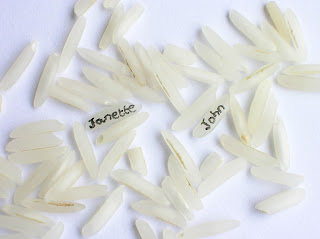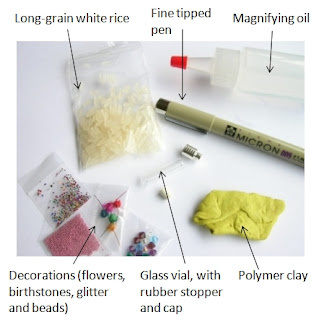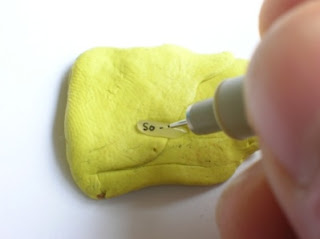Name on rice jewellery is the ancient art of writing on a single grain of rice. Once mastered, rice writing is a rewarding and personalised art-form that is also said to bring good luck and prosperity.
 |
| Name on rice writing |
The following describes some of the processes involved in rice writing and a guide for making name on rice jewellery. It is intended to give a background to the art for those wishing to purchase or create Name on Rice jewellery.
If you would like to find out more about the symbolism and history of the art of rice writing, please visit our name on rice jewellery page.
If you would like to find out more about the symbolism and history of the art of rice writing, please visit our name on rice jewellery page.
Name on Rice Jewellery - Equipment
One advantage of rice writing is that very little specialist equipment is required and most items can be purchased from art and craft stores or online. The following are a basic list of equipment that is required to enable you to create name on rice jewellery.
 |
| Name on rice jewellery - Equipment |
Name on Rice Jewellery - Writing
This section provides advice on the art of rice writing and further information on how to make a piece of name on rice jewellery:
 |
| Name on Rice Jewellery - Writing |
Before you begin writing on a grain of rice, it is likely that the rice itself may have been preserved within a small amount of oil. Take a small pinch of the rice and lay it down onto a sheet of paper towel and cover with another sheet of paper towel for several hours to remove any oil present.
Once the oil has been removed from the rice, take a single grain of rice and lightly press it into a piece of polymer clay.
You are now ready to write on the grain of rice. Holding the pen close to the nib, carefully start to write onto your grain of rice. Some mistakes can be corrected by removing the ink by a light rub with a cotton bud, otherwise discard the grain and start again with a new one!
Every so often your pen may pick up oil residue from the grain of rice and this may cause it to stop writing. If this is the case, carefully blot the pen on a paper towel and it should continue to work.
Once you are happy with the rice writing, leave it for an hour to ensure the ink is dry before removing and placing within a glass vial. When removing the grain of rice from the polymer clay, it helps to have a toothpick or cocktail stick at hand.
Name on Rice Jewellery - Construction
This section is aimed at making a piece of name on rice jewellery once the rice writing has been completed:
 |
| Name on rice jewellery - Making |
Take a glass vial and press it into a small piece of polymer clay to keep it upright. Part fill the glass vial to approximately one third full with the magnifying oil and then add your grain of rice. To prevent air bubbles forming whilst filling and to allow the oil to enter the glass vial more easily, insert a needle into the glass vial (make sure that the needle is long enough so that it can be easily removed).
Fill the glass vial to approximately two thirds full with more magnifying oil and add small flowers and glitter as required. Add more oil to almost the top of the glass vial, remove the needle and wait for any air bubbles to rise to the surface of the oil.
You will probably find that the rubber stopper that fits into the end of the glass vial doesn't fit flush with the top of the vial. Cut the top of the rubber stopper off with a pair of scissors and push the stopper into the top of the vial.
A small air bubble is normal and does allow the grain of rice to move around more freely within the glass vial. Larger air bubbles can be removed by popping them with a pin or needle and more magnifying oil added to prevent the air bubbles from reforming.
Apply a small amount of Superglue over the plug and around the rim of the glass vial to seal the contents. Apply a small amount of Superglue inside the cap and place the cap straight down onto the vial.
Apply a little pressure to the by holding the name on rice jewellery glass vial between thumb and forefinger for a minute. Leave the name on rice jewellery glass vial upright overnight to ensure the cap is securely glued.
Add any jewellery findings as required such as jump rings and key-chains and you have now finished your name on rice jewellery.
 |
| Personalised Name on Rice Jewellery |
If you would like to purchase our name on rice jewellery or would like to find out more about the history of this ancient art, please visit our name on rice jewellery page.

No comments:
Post a Comment
Thank you for your comment. I do appreciate the time and trouble taken to comment and I will reply as soon as possible.